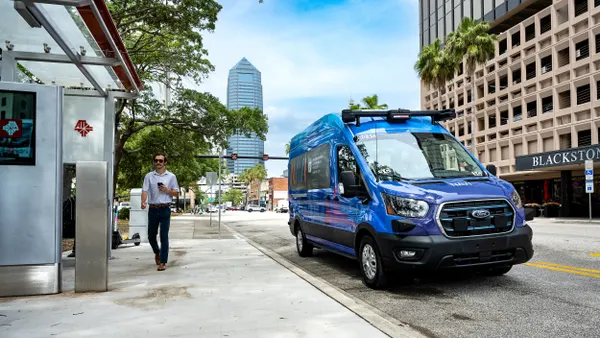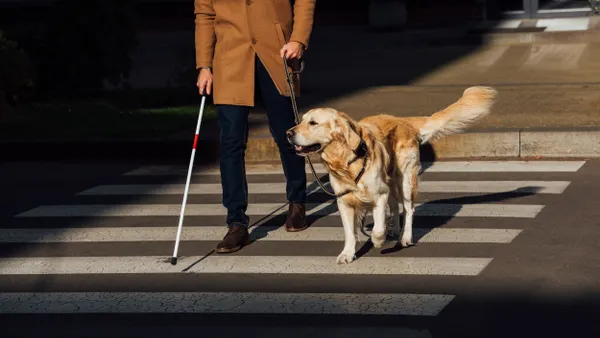Dive Brief:
- Mobility company OjO Electric intends to acquire competitor Gotcha Mobility and make its first step in micromobility sector consolidation, the companies announced in a press release.
- The acquisition exponentially expands the markets for OjO's seated scooters and expands its seated scooter product line to include pedal bikes, e-bikes, e-trikes and e-scooters. By the end of next year, the company expects to have 25,000 mobility devices in 80 locations.
- The companies say the acquisition will create an entity with North America's third largest micromobility footprint, behind Lime and Bird.
Dive Insight:
OjO's acquisition comes five months after mobility company Bird acquired competitor Scoot, kicking off what many predicted to be an upcoming micromobility consolidation trend. Micromobility analysts expect the merger and acquisition (M&A) activity will continue.
"I would expect elevated M&A activity in the micromobility space going into 2020," PitchBook Mobility Analyst Asad Hussain told Smart Cities Dive. "I think it's inevitable, really, for e-scooters because you've got all these different startups and a very fragmented market."
Although an increase in M&A sometimes indicates problems within an industry, Hussain doesn't believe that to be the case in this instance. He explains that venture funding in the micromobility space is down year-over-year, which indicates the market is maturing. Mature markets naturally experience more consolidation as industry leaders gain additional scale and some smaller businesses either fold or are purchased. "You're naturally going to see more consolidation at the tail end of the market," Hussain said.
Other indicators also signal that the industry is having a turnaround after overall lower micromobility investments in 2019 compared with 2018, he said. E-scooter companies in particular appear to be improving their unit economics by releasing more robust and durable devices than earlier models. E-scooters' short life cycle — commonly cited as only one month for the first models and three months for later ones — is lengthening to 10 months to a year for the newest models.
In addition, variable costs such as battery charging, maintenance, repairs and device depreciation are coming down. Operational changes and positive pricing trends show that "as [the companies] scale, they're doing so in an efficient manner and they're able to bring down their costs," Hussain said. "That's actually a huge factor in terms of whether or not these businesses can be sustainable."
Investors in all industries increasingly are prioritizing unit economics and margin sustainability as a key performance indicator (KPI) instead of traditional KPIs such as revenue growth, he added.
Such positive news is viewed favorably for micromobility investors, especially those who have invested in industry leaders such as Lime and Bird. The positive indicators could assuage fears of an impending micromobility industry collapse that flared up after last week's news that Lyft is ending e-scooter operations in six cities and is laying off nearly two dozen employees.
"This industry is still in flux so you're going to see... operators pulling out of certain cities and going into others. Broadly what we're seeing in this market is city officials and city planners are a lot more receptive to micromobility solutions than they were 18 months ago," Hussain said.
City leaders increasingly are welcoming and working with micromobility operators and adding related infrastructure into their landscapes. They're regulating the industry but considering it a means of offering low-cost first mile/last mile transportation that reduces traffic congestion and pollution.
For example, Minneapolis is piloting "mobility hubs" that bring together non-vehicular forms of transportation including transit and e-scooters. Ann Arbor, MI and Washington, DC took part in a two-month pilot project this summer in which solar-powered stations were installed for scooter docking and charging.
Besides more favorable city receptions, there are signs that micromobility could benefit from greater scrutiny and tighter restrictions on other industries such as ride-hailing. Shared bikes and scooters stand to become more attractive transportation options as cities including Chicago and San Francisco seek additional ride-hailing taxes.
New York spurred controversy last year when it became the first U.S. city to impose restrictions on ride-hailing. That industry also is feeling the squeeze from changes to gig economy employment regulations in California with the passage of AB5 this fall.
"Micromobility is in a good spot," Hussain said. "We're not seeing a race to the bottom that we have seen previously in adjacent mobility industries like ride-sharing and food delivery."
As micromobility matures further and more consolidation occurs, other forms of transportation likely will enter the space, just as scooters edged out dockless bikes in most U.S. markets earlier this year. But that doesn't necessarily mean scooters are in trouble.
"I think there's plenty of space in the last mile universe for multiple modes of transportation to exist — whether bikes or scooters or mopeds. It's an important segment of the market that's growing," Hussain said.
OjO's acquisition of Gotcha, a company that focuses on transportation modes different from its own, supports that thesis.










